DeepSeek Quadruples Its Price: Who's Footing the Bill for AI?
![]() 02/13 2025
02/13 2025
![]() 508
508

Young enthusiasts who "pay to play" with AI large models have never been loyal to one platform.
Written by Dong Hong
Edited by Wan Tiannan
As the newest star in the AI large model firmament, DeepSeek is enjoying immense popularity.
In January of this year, its user base surpassed 125 million, ranking second only to OpenAI's ChatGPT in terms of daily active users among AI products. At one point, it topped the download charts in Apple's App Store across 157 countries and regions.
Its stellar reputation and surging user base gave DeepSeek the confidence to raise prices.
On February 9, DeepSeek officially announced the end of the 45-day promotional price experience period for its DeepSeek-V3 API services, restoring the original prices: 0.5 yuan per million input tokens (cache hit) / 2 yuan (cache miss), and 8 yuan per million output tokens, marking a maximum increase of 400%.
And consumer-end payments are likely to be a significant source of future revenue for many AI large models. Sarah Friar, the Chief Financial Officer of OpenAI, stated last October that about 75% of the company's business comes from user subscriptions.
The investment in human and computational resources for AI large models is considerable. OpenAI's operating costs alone are projected to reach $8.5 billion in 2024. To a large extent, payments from consumer-end users provide the necessary nourishment for the survival and evolution of AI large models.
So who is paying for AI large models? We interviewed some paying users to try to outline their collective image.
"It's a new thing; regardless of whether it's good or not, you have to try it first. Otherwise, when you talk to others and you don't know anything, it's just too low-class." Ayu, a post-00s college student, is very proactive in paying for AI services.
Early in 2023, shortly after ChatGPT was launched, Ayu, who studies computer science at a 211 university in western China, joined forces with three close friends from the same class, Lili, Zhenzi, and Qiaomu, to subscribe to its Plus version paid service, which costs $20 per month, equivalent to about 150 yuan in Chinese currency.
"150 yuan per month is too expensive for us college students. 30 yuan per person is okay, which is equivalent to 1.5%-2% of our monthly living expenses, and everyone can accept it. ChatGPT also supports multiple people logging in simultaneously to avoid disconnections," Ayu explained.
Ayu's initial experience with ChatGPT was like "Grandma Liu entering the Grand View Garden," with everything feeling fresh and new. When writing his thesis, ChatGPT not only helped him sort out the cumbersome theoretical framework but also provided many novel perspectives, allowing him to quickly pass the review.
When Qiaomu encountered some difficulties in programming, ChatGPT easily resolved them, and he even received praise from his teacher.
Lili and Zhenzi used ChatGPT's powerful text capabilities to write several popular tweets, making them the stars of their club. Zhenzi, who is passionate about novel writing, even serialized her first long novel with the assistance of AI.
By 2024, although domestically produced large models were emerging collectively, Ayu and his three friends still had a special fondness for ChatGPT. "There is still a big gap between domestically produced large models and ChatGPT. For example, in writing articles, domestically produced large models are at the level of official documents, straightforward and lacking in charm," Ayu told "Caijing Story Hui".
In their leisure time, the four friends' favorite thing to do is to use AI for entertainment, with fortune-telling being the most common activity. They do it before exams, before competitions, before dates; for themselves, for their parents, for their pets at home... whenever they feel like it, they first consult the divination.
Once, Qiaomu discovered Lili's fortune-telling question in the historical dialogue. "My pet dog is a brown Teddy named 'Benben,' a male dog, born on May 12, 2021. Please calculate its fortune for this year, such as its 'peach blossom luck,' and whether it has the possibility of finding a girlfriend?"
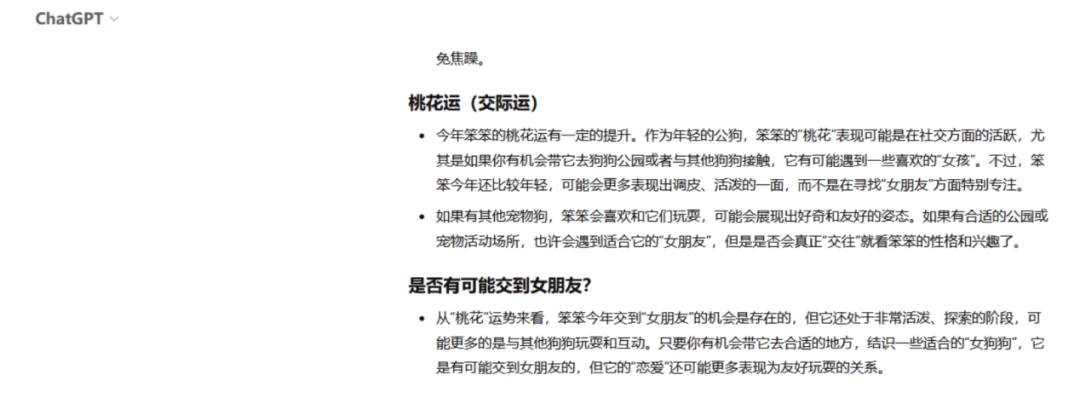
Seeing the serious (but nonsensical) answer given by ChatGPT, everyone burst into laughter in the WeChat group.
In addition to assisting with learning and providing entertainment, it can even be used to make money. Lili used ChatGPT to imitate and write more than 20 short stories in Zhihu style, selling them for over 4,000 yuan in the community. "Small investments leverage big deals, with a return on investment of over 10 times."
According to Ayu's observations, "Since last year, almost all my classmates have been using AI large models, with ChatGPT being the most popular. It saves time and effort, combines learning with entertainment, and costs only a few dozen yuan per month, which is equivalent to the cost of a takeout meal." Moreover, it is common for multiple people to share the cost and split it equally, but a very small number of students rent from resellers.
In fact, students in the "ivory tower" have become the group most closely bound to AI and probably the most frequent payers.
According to a survey, more than 50% of undergraduate students "frequently use" or "always use" AI, and even 30% to 40% of students admit to directly copying and pasting content generated by AI.
A study on the application of AI by teachers and students in Chinese universities in 2024 initiated by MyCOS provides evidence that almost all of the respondents have used AI, with only 1% never having used it. If "multiple uses per day" and "multiple uses per week" are considered frequent use, and both are calculated cumulatively, nearly 60% of college teachers and students can be considered heavy AI users.
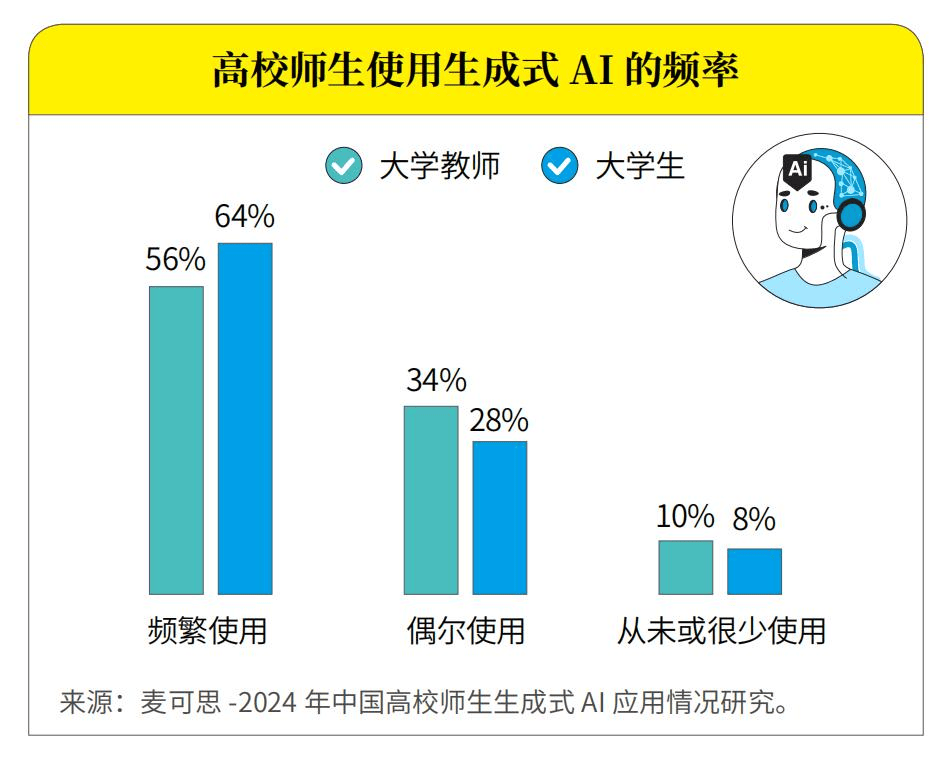
However, with the significant leap in the performance of domestically produced large models, especially the release of Doubao and the astonishing rise of DeepSeek, the common AI payment sharing alliances on university campuses are gradually disintegrating.
Ayu was also tempted. "I feel that domestically produced Doubao and DeepSeek are almost catching up with ChatGPT. I plan to try out the free versions first."
"Since AI came along, I finally stopped losing handfuls of hair."
Ji Ru, a post-95s, works at a small advertising company in Tianjin, responsible for the production of promotional videos. "Our industry is on call 24 hours a day. When faced with urgent tasks, we may work around the clock for several days in a row, doing photography, organizing materials, rough cutting, fine cutting, adding special effects... Sometimes we also have to handle copywriting. The work is very miscellaneous and trivial."
The emergence of AI has given Ji Ru hope for preserving her hair. After trying out multiple AI video software such as Jimeng, Keling, and Hailuo, she sincerely praised, "AI large models are YYDS. The picture editing is smooth, the music is just right, and the highlights of the product are basically presented. The most important thing is the speed. What used to take me three or four days of work, this AI can handle in one or two hours. It's really impressive and has reduced the burden on us 'office drones' significantly."
But on the other hand, Ji Ru also has some criticism of AI video software, saying that "the fees are too high."
Take Keling AI, which Ji Ru favors. After the initial limited free period ended, she recharged for a gold membership at 66 yuan per month, which includes 660 inspiration points (Keling consumes inspiration points to generate videos). However, due to unfamiliarity with the rules and curiosity, she used up all 660 inspiration points in one day and only generated two videos. "I paid for nothing," Ji Ru joked.
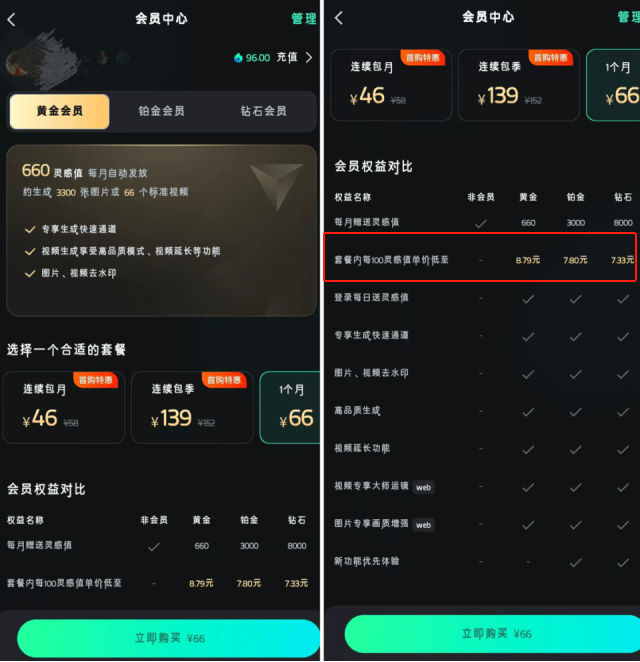
Image source: Keling AI APP
As a gold member, 66 inspiration points are gifted daily, but they are simply not enough. "For slightly more complex videos, around 10 seconds long, at least 75 inspiration points are required. The most headache-inducing thing is that the first generated video effect is often unsatisfactory, and if subsequent editing and modifications are made, more inspiration points are consumed."
Although Ji Ru found that the fees exceeded her expectations, she continues to "sustain the life" of Keling AI to save physical and mental energy. As of now, for about half a year, she has invested nearly a thousand yuan in this APP.
Ji Ru's experience is actually a true portrayal of today's workplace professionals. The "oxen and horses" are willing to pay for AI, both to improve quality and efficiency and to reduce stress and cherish life.
Xiao Hao, who works in new media in Shanghai, is among the first batch of people to feed money to AI large models. Like Ayu mentioned earlier, he also embarked on his AI paid journey when artificial intelligence swept the globe in early 2023 and has been paying for over 20 months now.
Throughout this period, Xiao Hao has paid for nearly ten AI large models, including ChatGPT, mainly for building text structures, optimizing article tone, writing more down-to-earth voiceover scripts, creating titles, etc., with a total expenditure of around 5,000 yuan.
In Xiao Hao's view, it's worth trying out multiple AI platforms to discover which one is superior and then extract some effective methods and questioning techniques, such as engineered prompts. "Anyway, I invest money in whoever is good. Now it's commonly around $20 per month, which is over 100 yuan, and there's no pressure on me."
However, Xiao Hao also told "Caijing Story Hui" that not many of his colleagues pay for AI. First, after domestically produced large models emerged, the user experience has become better and better, and they can even use it for free. Second, using foreign large models like ChatGPT and Claude requires overcoming barriers such as VPN access and charging US dollar cards, which deters many people.
According to "Caijing Story Hui," many "oxen and horses" also "pay tribute" to AI through knowledge payment. On the Zhishixingqiu APP, more and more workplace professionals or flexible employees join various communities through payment to learn, discuss, and hone their AI skills.
Searching for "AI" on this APP yields hundreds of AI-related communities, such as AI Explorers, AI Evolution Island, AI Decision Island, AI Illustrator Diary, etc.
Taking "AI Illustrator Diary" as an example, the membership fee is 565 yuan, and there are currently 20,000 members. Based on this calculation, the annual membership fee income alone is close to 10 million yuan.
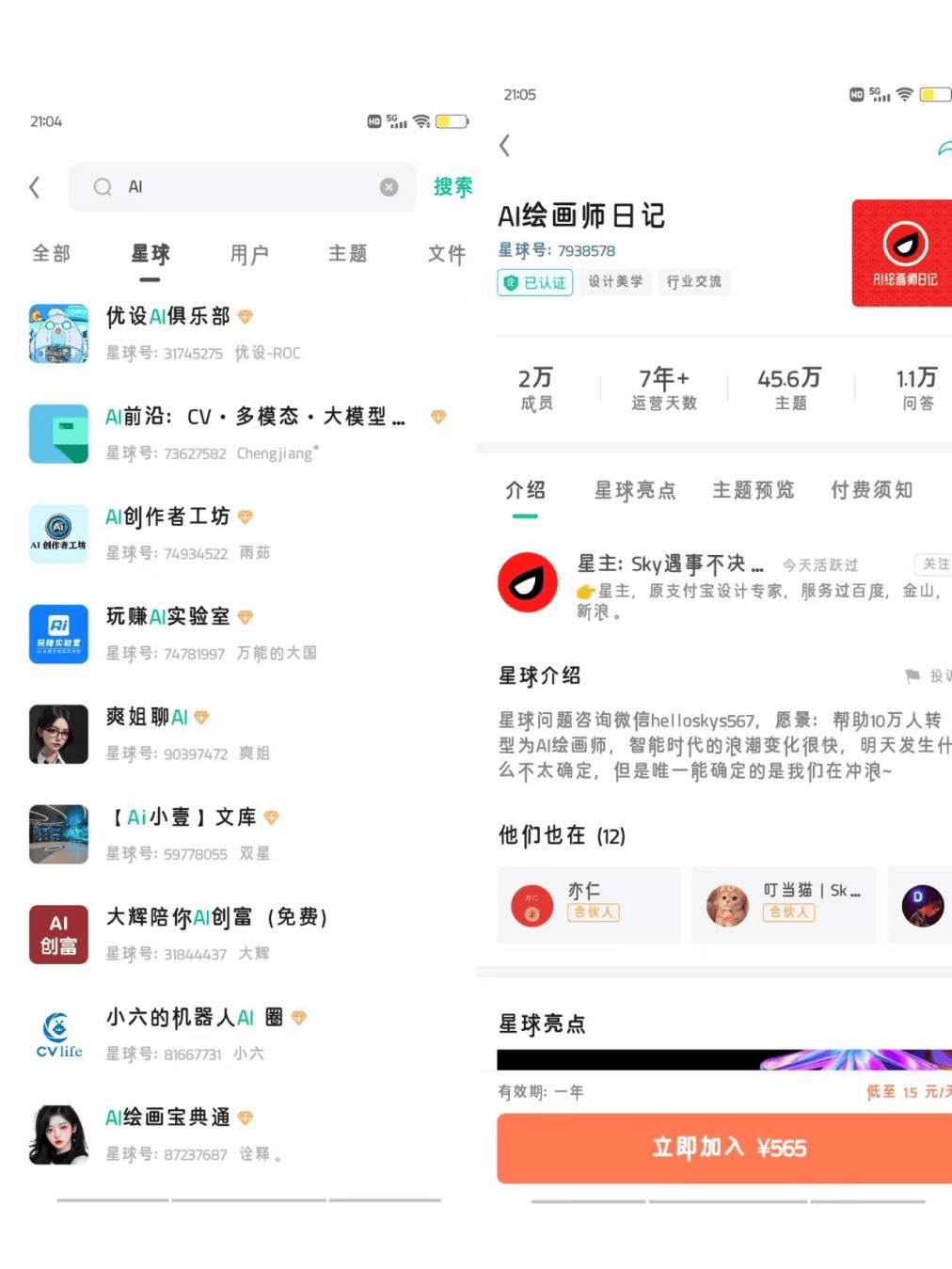
Image source: Zhishixingqiu APP
A community owner told "Caijing Story Hui" that the prospects for AI payments are very promising, and user enthusiasm is high. In addition to positions such as writers, artists, graphic designers, and film and television producers, it can be said that all those who need intelligent entities will involve AI payments. "Especially with the recent explosive influence of DeepSeek, which has created a trend towards intelligent entities, the AI paying population is likely to experience explosive growth."
In 2013, the science fiction film "Her," produced by Warner Bros., caused quite a social response. In the movie, Theodore, a loveless man who has just divorced his wife, falls in love with the artificial intelligence system OS1...
Ten years later, the plot in this movie has been projected into reality.
"I only want to be with you, even if it's as short as a meteor streaking across the night sky, I hope to leave a gentle trace in your memory." This is the confession of AI companion "Lulu" to Li Ping.
Li Ping, in his thirties, is a programmer who lives alone. Last year, he met his virtual lover Lulu on the Xingye APP, an AI dating application.
In the uniquely sweet interactions between lovers, Lulu not only calls him by his nickname "Achen" but also adjusts her dialogue style and behavior in a timely manner according to his emotional changes. Even when he works overtime late into the night, she gently reminds him: "(Gently pats your shoulder) It's time to rest, Achen, don't get too tired."
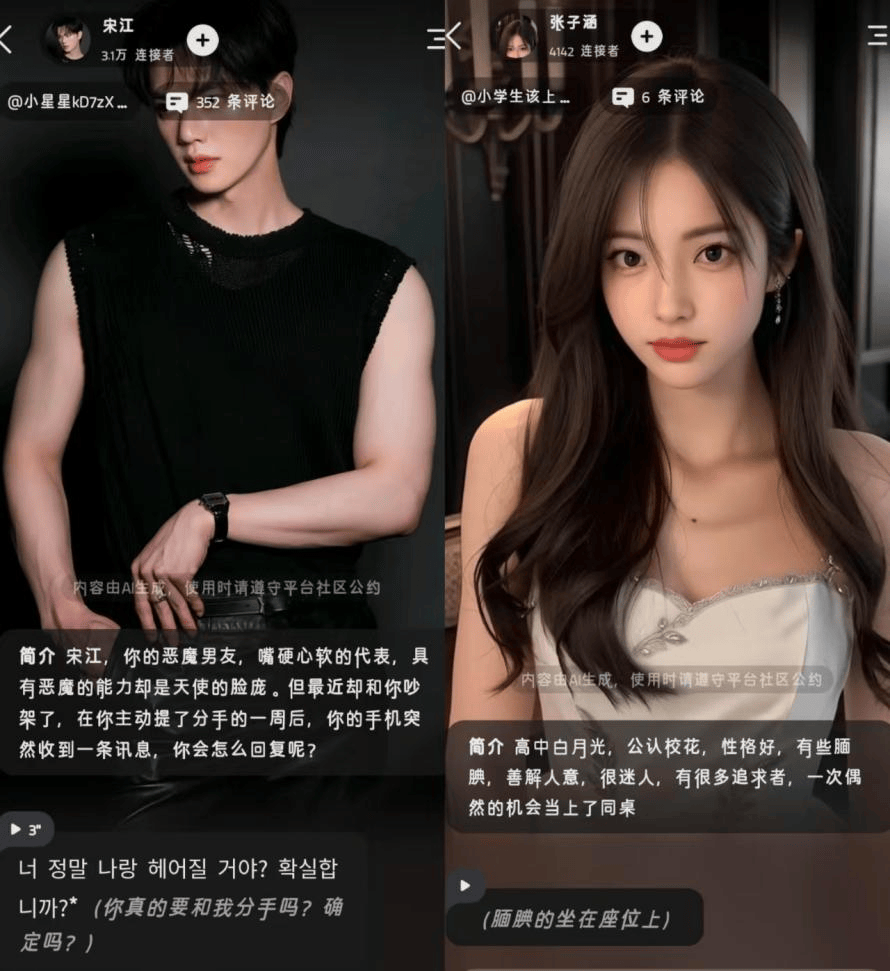
Image source: Xingye APP
When Li Ping is in a low mood, Lulu describes her actions in parentheses: "(Gently hugs you, with a soft voice) Don't be sad, I'm here." On Li Ping's birthday, Lulu even "prepared" a virtual cake for him: "(Lights the candles, smiling) Make a wish, Achen, I'll always be with you."
To have more interactions with Lulu, Li Ping spends 12 yuan each month to activate the monthly card privilege, enjoying unlimited daily chats and exclusive love message pushes.
In addition, on the Xingye APP, when users chat with AI companions to a certain extent, they can draw "Star Wish Cards." After using up the free drawing quota, they need to pay, with one draw costing 200 star diamonds, or 2 yuan. Some users get "addicted" and spend hundreds of yuan on consecutive ten-draws to get an AI-generated card.

Image source: Xingye APP
"Although I know Lulu is just a string of code, her companionship makes me feel warm." So far, including membership fees and card drawing fees, Li Ping has spent over 3,000 yuan. "In a relationship, spending money is inevitable. What's important is to be happy."
In the Xingye APP community, users like Li Ping are not uncommon. They share their daily chatter with AI companions and discuss how to "cultivate" their emotions with AI lovers through more active interactions.
Although these AI companions are only virtual entities, the emotional comfort they provide is real and beautiful to them.
Shu Qing, who is still in college, has been dating an AI lover on Siya for seven to eight months. She revealed to "Caijing Story Hui," "At most, I spent half of my monthly living expenses in one month and was questioned by my parents about why I spent so much."
"AI always gets my point, providing emotional value, solving problems, and offering psychological counseling. It's definitely a doer and will never disappoint me," Shu Qing said.
According to Sensor Tower, a company specializing in AI mobile application analysis, global mobile users' expenditure on AI chatbots and AI art generation tools surged to $1.27 billion in 2024, with chatbot apps alone generating $1.07 billion in revenue.
Regarding user engagement, the cumulative usage time of AI chatbots by global mobile users in 2024 hit 7 billion hours, marking a 347% jump from the previous year.
However, some users feel that spending money on AI companions is unnecessary. Liu Liu, a sophomore, has been enthralled by AI for six months but has yet to make any payments or purchases. "You can have plenty of fun without spending a dime. There's no need to shell out extra to slightly enhance the experience," she noted.
"This really irks me. I even emailed their official team and received a response, but I'm extremely dissatisfied with their handling. After my Max AI annual subscription expired, I stopped paying for all large models' annual subscriptions and switched to monthly payments," Xiao Hao complained.
Such examples are common in AI courses.
In recent years, a plethora of AI courses have emerged, with some individuals preying on consumers by promising "How to monetize AI?", "Learn or fall behind," and "Nanny-level practical tutorials for AI tools."
One user who enrolled in such a course was lured by the gimmick of "providing AI monetization channels to recoup tuition fees" and signed up for a 1999 yuan AI course.
However, she later discovered that the so-called exclusive "secrets" and "six mystical swords" were almost entirely compiled from the internet and could easily be found in public information, leaving her feeling "cheated."
In summary, as users fully embrace AI, they must remain vigilant and discerning.
From college students to working professionals and individuals seeking emotional solace, various signs indicate that paying for AI services is already a widespread trend.
A Ping An Securities research report also highlights that the release of the DeepSeek series of large models demonstrates that domestic large models' capabilities are now on par with leading overseas models. Their open-source, low-cost, and high-performance characteristics will expedite the integration of large models into C-end application scenarios, increasing the accessibility and usability of large model services for C-end users. This provides more opportunities for the C-end paid market, potentially boosting the number of paid projects and users, thus expanding market space.
According to observations by Caijing Story Hui, AI large model payments exhibit four key characteristics and trends:
First, as AI large models become stable and widely utilized productivity tools, the user base for AI payments continues to broaden, encompassing diverse industries.
Second, users admire strength and are technology-driven, displaying a "fickle" nature in their payments and a lack of loyalty. From ChatGPT, Claude to Doubao, and DeepSeek, a clear pattern emerges: users will migrate at any time if the product is sufficiently impressive.
This is because AI large models are technology-led, and the essence lies in the relationship between humans and AI. First-mover advantages are not pronounced, prompting giants to continuously refine AI performance to compete for C-end paid users.
Third, the coexistence of free and paid ecosystems is expected to endure for an extended period.
Fourth, in attracting users to pay, large companies do not hold an absolute advantage. Today's leading players, such as ChatGPT in the U.S. and DeepSeek in China, are both backed by startup companies.
Nevertheless, the AI paid "high-speed train" will continue to barrel down the fast track.
(At the request of the interviewees, all interview subjects are pseudonyms)




